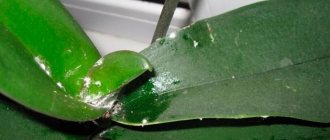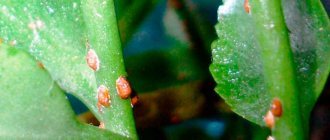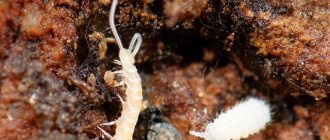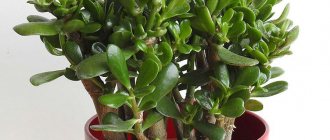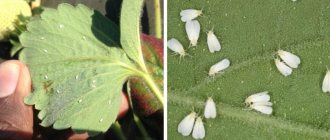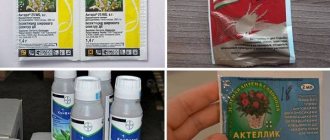Ways of bugs appearing in pots
Most often, it is white bugs that appear on indoor plants. There are a number of ways for beetles to appear in the soil:
- through an open window from the street. This happens if the larvae or adults are on trees;
- poor quality
White bugs in a pot.
the soil that was brought. This problem often arises if the soil for planting is not purchased, but collected;
- soil moisture is too high, which causes rotting;
- various midges and insects that like to lay their eggs in the ground.
Where do pests on indoor plants come from?
Pests of indoor plants do not initially live in apartments. There are several ways they can appear in your home, which can sometimes be difficult to protect against. But if you regularly inspect both the plant itself and the soil in a pot or flowerpot, it is not difficult to notice the parasite at an early stage of its appearance.
How can bugs appear in the soil?
Main options:
- an insect can fly into a room through an open window or window, or it can be carried in the same way by gusts of air. It is impossible to prevent such an ingress, especially in the hot summer;
- it gets into the house along with soil, even bought in a store;
- the pest is able to enter the house on an already infected plant;
- it gets on clothes or shoes;
- Parasites enter your living space on the fur of pets after a walk.
IMPORTANT! If you do not notice the appearance of these unexpected guests in time, they will multiply so much that the green “pet” will die. The process will accelerate if you do not follow the rules of agricultural technology.
Sometimes, however, it happens that the parasites themselves disappear without a trace when the air humidity changes or the soil dries out. But you shouldn’t hope for it, it’s better to start the fight yourself.
Types of white beetles in flowers
To determine the method of combating the infestation, it is necessary to understand what type of pests attacked indoor flowers. There are a number of common white beetles that can live in the soil.
How to get rid of small white and black insects?
There are many pest control products available on the market. You just need to apply them correctly and on time.
Treating flowers with chemicals at home
There are several well-proven drugs:
- Aktara - considered a universal remedy, destroys insects in 30 minutes, 4 g of the drug is diluted in 5 liters of water and sprayed;
- Actellik - one ampoule is enough for 5 liters of water, acts in 20 minutes;
- Inta-Vir is a preparation for soil treatment, 1 tablet dissolves in 10 liters of water.
All work should be carried out in a ventilated area using protective equipment. It’s even better to do it outdoors, if possible.
Use of folk remedies
There are also non-toxic products:
- laundry or tar soap is diluted in water and the plants are periodically sprayed; As a rule, insects disappear within 2 weeks;
- water the soil with a solution of potassium permanganate;
- orange zest is infused with vodka and sprayed on the stem, leaves and soil.
Parasites cannot tolerate garlic and tobacco infusions.
Prevention measures
To protect indoor flowers from various insects, you need to follow a few simple rules.
- Do not over-moisten the soil; leave it to dry between waterings.
- Monitor air humidity. The room should always have an optimal level of humidity, not excess.
- Periodically inspect indoor flowers for pests. A putrid odor may also be a symptom.
- Periodically water and spray with potassium permanganate.
- All new plants brought in from the street must be quarantined for 14 days.
- When replanting, use only special, purchased soil. And it is even recommended to disinfect it, warm it up or freeze it.
- If pests are found on one of the plants, you need to treat everyone nearby.
Pests of indoor flowers and measures to combat them. First and second parts.
1. Aphids. Perhaps I’ll start with a fairly simple pest, since it’s quite easy to notice it on a plant; it settles in large colonies, usually on the fleshier, juicier and more tender parts of the plant, leaving a sticky, sweetish coating behind. These are small insects, approximately 0.5-2 mm, have an ovoid body, long legs, and come with or without wings. They reproduce super quickly) maybe because aphids do not always need a female to reproduce; aphids often breed their own “clones”. There are many species and they are distinguishable by color, usually from yellowish, greenish (greenhouse aphid) to black (beetroot).
Aphids, if there are a lot of them, can greatly weaken the plant. Inspect plants in summer, as aphids are carried by the wind when windows are open. I became familiar with these pests a long time ago. I won’t say that in the garden you can always see it on one plant or another, not always on a home plant, but there are chances. An aphid has settled on my guzmania. The struggle was quite easy and painless for the victim herself. First, I bathed in the shower, tilting my growth point so that water would not pour in there. Using laundry soap, I went through all the leaves with a foam sponge. Thus, I got rid of both insects and sticky plaque. I let it dry and sprayed it with Fitoverm. A week later I examined the plant, there were no aphids, but for peace of mind I sprayed it again)
Folk remedies for deliverance (tested by forum participants)
— zoo shampoo against ticks and fleas. Dissolve a small amount and spray the plant (3-4 times)
— Garlic infusion: Grind 20-30 grams of unpeeled garlic in a meat grinder, add 1 liter of water, leave for 1 day.
- Pour 100 g of dry citrus peels into 1 liter of warm water and leave for three days in a warm place. Then spray.
Insecticides against aphids - Fitoverm, Intavir, Aktara, Konfidor.
2. Thrips.
Did you know that you can encounter thrips almost every day?) How? Take an onion bulb and remove the top layer of peel. Could the second layer of husk be sticky and unpleasant? And even with a silvery tint) This is it, or rather not the bug itself, but its action. You can also sometimes notice an adult individual on the bulb. By the way, it is also easy to find on dandelions) they, like a “jack-in-the-box”, always crawl out of the axils of the petals.
Thrips are not so easy to spot on a plant. Its body is elongated and slender, measuring from 0.5-2 mm (rarely up to 5 mm). The color is unsightly, often black, gray, brown. The larvae are white-yellow and grayish. There are a lot of varieties - bulbous thrips, dracaena, rose, tobacco, decorative.
In general, these comrades are omnivores) they can eat both a delicate rose and a not-so-delicate cactus. Therefore, inspect not only the infected plant, but also the one standing nearby, even if it is a 2-meter palm tree)
Larvae and adults suck cell sap from plant tissue. This initially causes yellow or discolored spots, streaks, or a peculiar streaking appearance; gradually these strokes and spots merge. Damaged plant tissue dies, resulting in holes; leaves wither and fall off. Flowers lose their decorative effect and fall off prematurely.
When infested en masse, “silver” areas are visible on the plants, and curvature of the stems is often noted. Thrips-infested plants show traces of excrement.
As a preventive measure, humidify the air in the apartment; thrips do not like humidity. Give your plants a shower, it's useful. Inspect the undersides of the leaves.
Thrips is my friend at the moment, since he settled on my hibiscus. The saddened hibiscus now stands on the reservation with other plants that stood side by side. You are the one to blame(
Getting rid of thrips is not easy, but it is possible. What did I do? She took the hibiscus to the bathroom, diluted 2 ml of fitovrem into 200 ml and began to carefully spray each leaf, thereby knocking down both the larvae and the parent itself under the pressure of the stream. I wrapped the hibiscus in a bag. The place where the plants stood was washed with disinfectants. I removed the top layer of soil from the hibiscus and added a new one. I'm waiting for re-processing. In total, you need to do 3-4 treatments with an interval of 4-6 days.
Insecticides effective against thrips - Fitoverm, Aktara, Vermitek, Confidor.
Folk remedies work for small infestations, but for severe infestations you need to use insecticides!
Attention! Thrips are carriers of many plant diseases. After getting rid of thrips, it is advisable to treat the plant with a systemic fungicide.
3. Scale insect, false scale insect.
In fact, there are many varieties of them and they can be eaten, like all thrips)
The body of an adult scale insect has a hard, waxy shield, which is why spraying with insecticides does not always work on them. However, young insects do not yet have a scutum. Larvae and adult females suck plant juices. Scale insects can be from 0.5 mm to 5 mm in size. The shield can be either round or elongated. False scale insects, or coccids (Coccidae)
They differ from true scale insects in that they do not have a waxy shell.
Scale insects and pseudoscale insects secrete a sticky liquid on which sooty fungus can settle.
Females are immobile, but males can even fly during their lives . However, the life cycle of the male is very short. They live only a few days, unlike females, who live for several months.
Prevention - spraying the plant and ventilating the premises.
I became acquainted with the scale insect a long time ago, when my mother brought me one infected flower. It’s not easy to get rid of it because of the shell, but again it’s possible and necessary. It is advisable to mechanically remove them from the plant. Gently, without damaging delicate tissues. If there are a lot of them on some part of the plant, if possible, then it is better to cut off the damaged part.
If the injury is minor, alcohol diluted with soap will help you. You can carefully wipe the areas where scale insects accumulate with a cotton pad. In case of severe damage, use only insecticides and be sure to water the plant, not just spray it.
Remedies against scale insects - Aktara, Bankol.
4. Whitefly.
It’s beautiful when butterflies fly) ... but not at home and not when there are a huge number of them)
A small white butterfly, no more than 3 mm, which settles mainly on the underside of the leaf. Fuchsias are most susceptible to whitefly, especially when kept warm in winter, as well as pelargos, especially fragrant, royal and angels, also when kept warm. Whiteflies also love mint)
It is easy to detect if you lightly touch the infected plant; many white small butterflies fly into the air. A shiny coating often appears on the upper side of the leaves. A sooty fungus likes to appear on whitefly feces, causing the leaf to first turn whitish and then turn black. Whiteflies are carriers of viral diseases!
The whitefly is a pampered companion, therefore, by observing the temperature limits inherent in each plant in its individual period, the risk of its occurrence is sharply reduced.
For prevention in summer and winter, you can water the plants with Aktara solution. This is usually enough to prevent whiteflies from appearing.
Poisons - Aktara, Konfidor, Mospilan, Fufanon.
Folk remedies - garlic infusion and cool conditions.
In the second part we will discuss mites, soil scale insects, nematodes, springtails, fungus gnats, etc.
py.sy. thank you very much to the site
Pests of indoor plants. Control measures. Part 2.
So here's the second part. Here we will look at the remaining pests and how to deal with them. In this article I did not write my measures of struggle, I did not make it too personal. If you have any questions, write.
1. Spider mite. Almost all gardeners know this enemy by sight, because it is one of the most common pests. It occurs unexpectedly and is difficult to notice at first glance until the plant makes it known that it is sick.
Visible signs - in advanced cases, a cobweb is visible, at the first signs of damage - small white dots on the back of the leaves, drying out, yellowing of the leaves, the plant sheds its leaves, deformation of the growing leaves and buds.
The life activity of the tick, as well as its reproduction, directly depends on the air temperature. The higher it is, the better it is for the tick. It is worth noting that under poor conditions for ticks (cold weather, high air humidity), females can hide in the soil, under fallen leaves, or cracks in pots. Therefore, when caring for a plant, it is important to collect dry leaves, wipe the leaves with a damp sponge or wash them in a warm shower.
Control measures include spraying the plant with effective acaracid preparations, such as Fitoverm, Actellik, Fufanon, Neoron, Sunmite, Nissoran, Oberon, Omite-30, Bi-58, Admiral, Karate.
From available means - Green soap, laundry soap, pet shampoo for fleas and ticks.
It is important to combine several poisons, since ticks adapt to poisons quite quickly.
2. Flat mite or flat mite. Red mite.
It often settles on ficus, citrus, euonymus, cacti, aucuba, and palm trees.
This mite does not produce webs and at room temperature from 18-25 degrees it behaves very actively. It is more difficult to detect, but it is possible.
The leaves of the affected plant curl and dry out. Yellowish or grayish streaks appear on the leaves. Its lesions are somewhat similar to those of thrips.
Control measures are the same as for spider webs.
3. Cyclamen mite.
This comrade loves to eat cyclamens and violets, pelargoniums. Unlike spider mites, they love moisture. Therefore, the higher the air humidity, the better for it. It settles mainly on the upper side of leaves, the center of violet rosettes, tubers and cyclamen leaves; in large clusters it resembles dust. It is microscopic, so you won’t be able to see it without a magnifying glass. Lays eggs in cracks and depressions.
Traces of damage are curling and yellowing of leaves, deformation of leaves, “dust” on the leaves.
Control measures.
Spraying with pesticides (see above), generously wetting the leaves. Twisting out infected leaves and buds of cyclamen. Reduced air humidity. Removing flower stalks from violets.
4. Root mites.
Microscopic and very tenacious mites. More popular is the bulb mite, which likes to settle on the bulbs of gladioli, hyacinths, and tulips. It eats away the tissue of the bulbs and lays a huge number of eggs. A damaged bulb becomes loose and easily falls apart in your hands.
It loves humidity, so the main prevention is to store the bulbs and tubers in a dry and cool place!
It is worth mentioning here about Soil Mites.
There are mites in any substrate and you should not be afraid of this. Therefore, there is no need to be scared and stock up on poison when you see a tiny and transparent spider on the ground. Mites are of great importance for the normal functioning of the soil as a nutrient medium for plants. Among them there are also predatory mites that feed on pests of indoor plants. By the way, there are biological “poisons” against plant pests, these are these same predatory mites.
These mites are not dangerous for plants, but if there are too many of them in the soil, you should think about mistakes in caring for the plant.
5. Nematodes.
Round, small worms that live in moist soil on plants. They affect various plant tissues - roots, leaves, stems, buds.
As a result, plant growth is inhibited, the plant stem is bent and deformed, leaf petioles are underdeveloped, short internodes, and leaves die off. “Galls” or thickenings appear on the roots.
Security measures:
1. Do not take soil from the area where crops are grown.
2. Do not take questionable soil mixture or sterilize it thoroughly.
3. Disinfect tools, pots, trays.
Control measures.
Use of a systemic nematicide (carbosulfan).
6. Enchitrea.
Small, about 1 cm, ringed white worms that live in contaminated soil.
They feed on the roots of the plant, so the affected plant lags in growth, falls out, yellowing of the leaves occurs, and then the complete death of the plant. Waterlogging of the soil contributes to the appearance of enchytrae.
Control measures.
Washing the roots of the plant from the old soil, replanting it in new soil. Spill of soil by Aktara.
7. Mealybug.
Sucking insects are about 3-3.5 mm in length. Oval body with growths, usually whitish or pinkish. They settle mainly in the leaf axils of the plant, and in case of large infestation - on the leaves and stem of the plant.
A winged insect has one pair of wings. The larvae can settle on the root collar of the plant. The eggs are protected by a cotton-like secretion.
The affected plant sheds its leaves, shoots lag behind in growth, and sooty fungus often forms on the mealybug secretions.
Control measures.
Removal of adults manually or using a cotton swab. Spraying with systemic insecticides Fitoverm, Aktara, Vermitek.
8. Root mealybug.
White, 2-3 mm long. They settle on roots and well-aerated substrates. It can only be discovered by digging up the plant.
The affected plant partially loses turgor, sluggish appearance, deformation and death of leaves.
Cacti and succulents are most susceptible.
Control measures.
Spill the soil with actelik, karbofos, actara, decis several times with an interval of 5-7 days.
Folk remedy. https://floralworld.ru/illnesses_wreckers/rhizoecus.html
9. Springtails, fools.
Small white insects that live in moist soil. They feed on organic residues in soils.
Podurs can move in the soil in a unique way. Some species have a special organ on the abdomen, the so-called “jumping fork,” with which it makes jumping movements. Some species do not have a jumping fork; they crawl on the ground.
A number of springtails harm the plant, like green sminutur, which eats into the roots of greenhouse plants. Some carry fungal spores that can cause plant infection. In general, springtails are harmless to plants, but they even benefit them, playing a major role in soil formation.
Control measures.
Do not allow the soil to become waterlogged. Keep the plant in drier conditions. Cut the raw potato into halves and place it cut side down on the soil. After the insects stick around the potato, take it out and throw it away.
10. Fungus gnat, sciarids.
A small flying black and gray insect with a narrow body and a rounded head. Adults do not harm plants, but their larvae living in moist soil can gnaw at the tender roots of the plant.
Inspect the soil, if you do not see mosquito larvae in the ground, then there is no need to panic, it is enough to destroy the flying insects using sticky tape or dichlorvos. If there are larvae, then you need to sprinkle the soil with Bazudin, Grom-2, Pochin powders.
Control measures.
Do not over-water the soil. Keep the plant in drier conditions.
For flying individuals - tape, neo-dichlorvos.
For larvae - powders Grom-2, Bazudin.
Types of insects
In order for your pest control to be as effective as possible, you need to determine what kind of midge is in front of you. Maybe a moth? Or thrips? In order to answer this question, we will talk about the most common types:
- aphids - small insects in the bathroom, yellowish-greenish in color, oblong in shape;
- whitefly - white insects in the soil of indoor plants, resembling butterflies no more than 3 mm;
- Podura springtails are a lichen-eating pest, a small white insect with long antennae.
If such midges are destructive to plants, the logical question is whether they can cause harm to humans. As far as we know today, insects that live on flowers are quite unpleasant, but they are not capable of harming human life and health, since they are destructive exclusively to plants. Therefore, do not panic if you notice such “living creatures” on orchids or any other flowers.
Ways to fight
The most popular methods of combating small white insects that have appeared in the ground are presented in the photo.
If you have noticed any pot pests, you need to know how you can quickly and easily get rid of them. After reading the descriptions of these three products, you will no longer wonder what to do and how to get rid of white insects in the bathroom.
The advantage of this product is that it is easy to spray and does not emit a persistent unpleasant odor when used. However, its effectiveness remains in question, since according to user reviews, plants have to be processed several times.
Aktara is good because it does not cause any harm to plants, carefully gets rid of insects, and also does not disturb the condition of the earth. The downside is that some especially tenacious individuals are able to stay and breed again.
Fitoverm is a powerful remedy against pests that will not leave them any chance of survival. However, it is difficult to find it in the store, since the product is quite rare, and it is also worth considering that it is not suitable for all types of plants.
Means for controlling midges
In a situation where you do not trust store-bought products and doubt their effectiveness in combating small black insects that have appeared on indoor plants, home remedies will be a real salvation. They are also useful when you are concerned about the health of your flowers.
1. Orange with alcohol.
What you will need:
- orange;
- alcohol;
- container with a spray bottle.
- Peel the oranges.
- Pour alcohol into the container.
- Cut the orange zest into small pieces and add to the container.
- Leave for 2 weeks, then spray the soil around the plants.
After completing this operation, you can be sure that pests no longer live on the flower.
2. Water with potassium permanganate.
What you will need:
- Warm up the water.
- Add potassium permanganate crystals until a rich purple color is obtained.
- Water the soil and spray the leaves of the plants.
This product is effective for small insects of any name that may live in your apartment, and photos of which you can see below.
3. Tar soap.
What you will need:
- Heat the water until warm.
- Carefully dissolve the soap.
- Sprinkle the soil with this solution.
This method is quite simple, much simpler than those you could see earlier in the video, however, it is quite effective.
Purchasing drugs
If you are faced with this problem and trust only industrial products, below are the addresses of stores where you can purchase the drug Aktara in Moscow, St. Petersburg, Yekaterinburg, Chelyabinsk, Minsk and Kyiv:
| Name | Address | Cost, rub |
| Gazonov | Moscow, st. Dubninskaya, 75A, building 7, office 9 | 104 |
| Obi | Saint Petersburg | 110 |
| Magazine-naturalist | Ekaterinburg, st. Mashinostroiteley, 14 | 127 |
| Leroymerlin | Chelyabinsk | 114 |
| Minsk | Minsk | 105 |
| Agro-store | Kyiv | 112 |
Insects in dreams
Often, the appearance of certain symbols in a dream can tell some secrets about a person and his future. Often, certain images can be imprinted in a child’s head, which are reflected in a dream - midges are a frequent occurrence. Today we will find out how to understand that you dreamed of insects:
- According to Longo’s dream book, seeing insects speaks of a person’s preoccupation with minor problems.
- Maneghetti's dream book has a positive attitude towards the image of insects and interprets it as an opportunity for our own analysis.
- If you dreamed of an insect, this may also be a sign of illness according to the symbolic dream book, so you should pay special attention to your state of health.
Ways to get rid of midges in house plants
There are many ways to get rid of these harmful parasites - both chemical and folk. To get rid of insects, you should resort to the following measures.
First of all, when flower midges are detected, it is necessary to remove the affected flower away from other plants.
Flower soil in which insects have already settled should be thrown away. The flower is removed from the pot, the root system is washed and the already treated plant is transplanted into disinfected soil. There is an option to replace the top layer of soil.
If it is not possible to change the affected soil, it is recommended to treat it with an insecticide. More effective drugs against flower flies include Fitoverm , Aktara , Tanrek . Flycatcher insecticide , which is available in granules, is also effective in combating annoying midges.
If there are not too many pests yet, then fly sticky tape hung next to the flower pots will help catch them.
If there are already a lot of insects, then it is recommended to use aerosol preparations for destruction, such as Dichlorvos and Raptor . By lightly spraying the product, treat window sills, shelves, and walls located near house plants. Plus, the soil in the flower pot and its bottom. The result of the treatment will be the death of adult individuals and their eggs laid in the ground.
Another good remedy for midges is to reduce the number of waterings of the flower that has been affected by parasites. Dry soil will contribute to the death of the larvae.
Still, the best way to combat midges is to follow all the rules for the care and maintenance of house plants.
How dangerous are household pests?
Photo of an adult fool with multiple magnification
To be fair, it should be noted that only some species of collembola are classified as pests. But there are springtails that eat nematodes and enchytraeids, thereby bringing benefits. Insects feeding on rotting organic matter improves soil formation. The white fool is one of those four species of “brothers” that stand out for their harmfulness from the more than 4 thousand that live on earth. We can talk about the danger of insects in the case of a sharp growth of the colony, when there is not enough rotting residue in the pots to feed, and the thinnest thread-like roots of the root system begin to be eaten. Most often, orchids, violets, and gloxinias fall into the risk zone.
Attention! The appearance of springtails in indoor flowers is an indicator of waterlogged soil in pots and flowerpots and improper care of plants.

